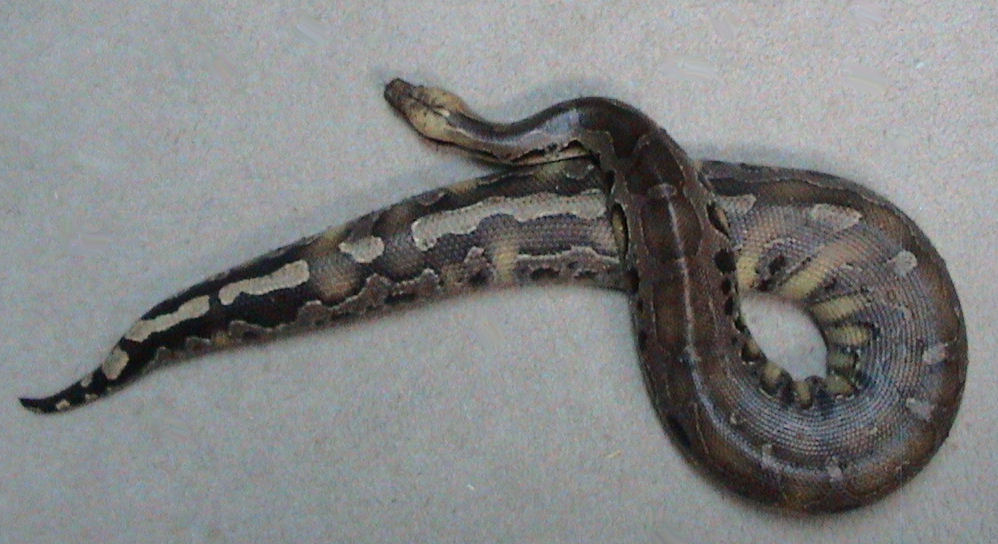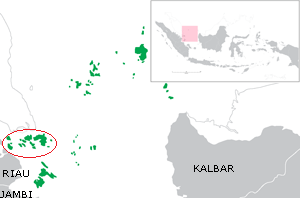|
Python Curtus
The Sumatran short-tailed python (''Python curtus'') is a species of the family Pythonidae, a nonvenomous snake native to Sumatra. Taxonomy ''Python curtus'' was the scientific name proposed by Hermann Schlegel in 1872 for a python with a short tail from Sumatra. The type locality is Sumatra.McDiarmid, R. W., Campbell, J. A., Touré, T. 1999. Snake Species of the World: A Taxonomic and Geographic Reference, vol. 1. Herpetologists' League. 511 pp. (series). (volume). Description The Sumatran short-tailed python has narrow subocular scales between the bottom of the eye and the top of the labial scales. The parietal scales do not join each other. ''P. curtus'' and '' P. breitensteini'' can be distinguished by the frontal and parietal scales on the tops of their heads. In both '' P. brongersmai'' and ''P. breitensteini'', the parietal scales join. Adults grow to in length and are heavily built. The tail is extremely short relative to the overall length. The color pattern consi ... [...More Info...] [...Related Items...] OR: [Wikipedia] [Google] [Baidu] |
Hermann Schlegel
Hermann Schlegel (10 June 1804 – 17 January 1884) was a German ornithologist, herpetologist and ichthyologist. Early life and education Schlegel was born at Altenburg, the son of a brassfounder. His father collected butterflies, which stimulated Schlegel's interest in natural history. The discovery, by chance, of a buzzard's nest led him to the study of birds, and a meeting with Christian Ludwig Brehm. Schlegel started to work for his father, but soon tired of it. He travelled to Vienna in 1824, where, at the university, he attended the lectures of Leopold Fitzinger and Johann Jacob Heckel. A letter of introduction from Brehm to gained him a position at the Naturhistorisches Museum. Ornithological career One year after his arrival, the director of this natural history museum, Carl Franz Anton Ritter von Schreibers, recommended him to Coenraad Jacob Temminck, director of the natural history museum of Leiden, who was seeking an assistant. At first Schlegel worked mainl ... [...More Info...] [...Related Items...] OR: [Wikipedia] [Google] [Baidu] |
Lingga Islands
The Lingga Regency ( id, Kabupaten Lingga) is a group of islands in Indonesia, located south of Singapore, along both sides of the equator, off the eastern coast of Riau Province on Sumatra island. They are south of the populated Riau Archipelago, known for the industrial island of Batam and the tourist-frequented island of Bintan, although the Lingga Islands themselves are rarely visited due to the infrequent local transportation. The equator goes through the northern tip of Lingga Island, the main island in the archipelago. Administratively they form a Regency of the Riau Islands Province with an area of 2,266.77 km2 and a population of 86,244 people at the 2010 census and 98,633 at the 2020 census.Badan Pusat Statistik, Jakarta, 2021. The regency seat lies at Daik on Lingga Island. The population are mainly Malay, Bugis and Chinese (predominantly Hakka, Teochew and Hokkien). Name Lingga derives its name from the profile of which is shaped like the Hindu linga ... [...More Info...] [...Related Items...] OR: [Wikipedia] [Google] [Baidu] |
Reptiles Of Indonesia
Reptiles, as most commonly defined are the animals in the class Reptilia ( ), a paraphyletic grouping comprising all sauropsids except birds. Living reptiles comprise turtles, crocodilians, squamates (lizards and snakes) and rhynchocephalians ( tuatara). As of March 2022, the Reptile Database includes about 11,700 species. In the traditional Linnaean classification system, birds are considered a separate class to reptiles. However, crocodilians are more closely related to birds than they are to other living reptiles, and so modern cladistic classification systems include birds within Reptilia, redefining the term as a clade. Other cladistic definitions abandon the term reptile altogether in favor of the clade Sauropsida, which refers to all amniotes more closely related to modern reptiles than to mammals. The study of the traditional reptile orders, historically combined with that of modern amphibians, is called herpetology. The earliest known proto-reptiles origin ... [...More Info...] [...Related Items...] OR: [Wikipedia] [Google] [Baidu] |
Python (genus)
''Python'' is a genus of constricting snakes in the Pythonidae family native to the tropics and subtropics of the Eastern Hemisphere. The name ''Python'' was proposed by François Marie Daudin in 1803 for non-venomous flecked snakes. Currently, 10 python species are recognized as valid taxa. Three formerly considered python subspecies have been promoted, and a new species recognized. Taxonomy The generic name ''Python'' was proposed by François Marie Daudin in 1803 for non-venomous snakes with a flecked skin and a long split tongue. In 1993, seven python species were recognized as valid taxa. On the basis of phylogenetic analyses, between seven and 13 python species are recognized. Distribution and habitat In Africa, pythons are native to the tropics south of the Sahara, but not in the extreme south-western tip of southern Africa (Western Cape) or in Madagascar. In Asia, they occur from Bangladesh, Nepal, India, Pakistan, and Sri Lanka, including the Nicobar Islands, t ... [...More Info...] [...Related Items...] OR: [Wikipedia] [Google] [Baidu] |
Leather
Leather is a strong, flexible and durable material obtained from the tanning, or chemical treatment, of animal skins and hides to prevent decay. The most common leathers come from cattle, sheep, goats, equine animals, buffalo, pigs and hogs, and aquatic animals such as seals and alligators. Leather can be used to make a variety of items, including clothing, footwear, handbags, furniture, tools and sports equipment, and lasts for decades. Leather making has been practiced for more than 7,000 years and the leading producers of leather today are China and India. Animal rights groups claim that modern commercial leather making and the consumption of its products is unethically killing animals. According to the life-cycle assessment (LCA) report for the United Nations Industrial Development Organization, 99% of the raw hides and skins used in the production of leather derive from animals raised for meat and/or dairy production. Critics of tanneries claim that they engage in ... [...More Info...] [...Related Items...] OR: [Wikipedia] [Google] [Baidu] |
Oviparous
Oviparous animals are animals that lay their eggs, with little or no other embryonic development within the mother. This is the reproductive method of most fish, amphibians, most reptiles, and all pterosaurs, dinosaurs (including birds), and monotremes. In traditional usage, most insects (one being '' Culex pipiens'', or the common house mosquito), molluscs, and arachnids are also described as oviparous. Modes of reproduction The traditional modes of reproduction include oviparity, taken to be the ancestral condition, traditionally where either unfertilised oocytes or fertilised eggs are spawned, and viviparity traditionally including any mechanism where young are born live, or where the development of the young is supported by either parent in or on any part of their body. However, the biologist Thierry Lodé recently divided the traditional category of oviparous reproduction into two modes that he named ovuliparity and (true) oviparity respectively. He distinguis ... [...More Info...] [...Related Items...] OR: [Wikipedia] [Google] [Baidu] |
Marsh
A marsh is a wetland that is dominated by herbaceous rather than woody plant species.Keddy, P.A. 2010. Wetland Ecology: Principles and Conservation (2nd edition). Cambridge University Press, Cambridge, UK. 497 p Marshes can often be found at the edges of lakes and streams, where they form a transition between the aquatic and terrestrial ecosystems. They are often dominated by grasses, rushes or reeds. If woody plants are present they tend to be low-growing shrubs, and the marsh is sometimes called a carr. This form of vegetation is what differentiates marshes from other types of wetland such as swamps, which are dominated by trees, and mires, which are wetlands that have accumulated deposits of acidic peat. Marshes provide habitats for many kinds of invertebrates, fish, amphibians, waterfowl and aquatic mammals. This biological productivity means that marshes contain 0.1% of global sequestered terrestrial carbon. Moreover, they have an outsized influence on clima ... [...More Info...] [...Related Items...] OR: [Wikipedia] [Google] [Baidu] |
Rainforest
Rainforests are characterized by a closed and continuous tree canopy, moisture-dependent vegetation, the presence of epiphytes and lianas and the absence of wildfire. Rainforest can be classified as tropical rainforest or temperate rainforest, but other types have been described. Estimates vary from 40% to 75% of all biotic species being indigenous to the rainforests. There may be many millions of species of plants, insects and microorganisms still undiscovered in tropical rainforests. Tropical rainforests have been called the "jewels of the Earth" and the " world's largest pharmacy", because over one quarter of natural medicines have been discovered there. Rainforests as well as endemic rainforest species are rapidly disappearing due to deforestation, the resulting habitat loss and pollution of the atmosphere. Definition Rainforest are characterized by a closed and continuous tree canopy, high humidity, the presence of moisture-dependent vegetation, a moist layer of ... [...More Info...] [...Related Items...] OR: [Wikipedia] [Google] [Baidu] |
Kalimantan
Kalimantan () is the Indonesian portion of the island of Borneo. It constitutes 73% of the island's area. The non-Indonesian parts of Borneo are Brunei and East Malaysia. In Indonesia, "Kalimantan" refers to the whole island of Borneo. In 2019, President of Indonesia Joko Widodo proposed that Indonesia's capital be moved to Kalimantan, and in January 2022 Indonesian legislature approved the proposal. The shift is expected to take up to 10 years. Etymology The name ''Kalimantan'' is derived from the Sanskrit word ''Kalamanthana'', which means "burning weather island", or island with a very hot temperature, referring to its hot and humid tropical climate. It consists of the two words '' kal ' ("time, season, period") and ''manthan ' ("boiling, churning, burning"). The indigenous people of the eastern region of Borneo referred to their island ... [...More Info...] [...Related Items...] OR: [Wikipedia] [Google] [Baidu] |
Bangka Island
Bangka is an island lying east of Sumatra, Indonesia. It is administered under the province of the Bangka Belitung Islands, being one of its namesakes alongside the smaller island of Belitung across the Gaspar Strait. The 9th largest island in Indonesia, it had a population of 1,146,581 at the 2020 census. It is the location of the provincial capital of Pangkal Pinang, and is administratively divided into four regencies and a city. Geography Bangka is the largest landmass of the province of the Bangka Belitung Islands. It lies just east of Sumatra, separated by the Bangka Strait; to the north lies the South China Sea, to the east, across the Gaspar Strait, is the island of Belitung, and to the south is the Java Sea. It is about 12,000 km². Most of its geography consists of lower plains, swamps, small hills, and beautiful beaches. It has white pepper fields, many palm trees and rubber trees, and well-known tin mines. The island's largest city, Pangkal Pinang, is also t ... [...More Info...] [...Related Items...] OR: [Wikipedia] [Google] [Baidu] |
Riau Archipelago
The Riau Archipelago is a ''geographic'' term (as opposed to administrative region) for the core group of islands within the Riau Islands Province in Indonesia, and located south of Singapore and east of Riau on Sumatra. Before the province of Riau Islands was formed, there was no ambiguity in term; however, in Indonesian language, both the archipelago and administrative province are referred to as simply "Kepulauan Riau". The province may have the word "Provinsi" preceding it for clarity. Additionally the term BBK for ''Batam Bintan Karimun'' may refer to the archipelago. History The name of this archipelago predates the creation of the Indonesian province, and historically did not include the Lingga Islands or Natuna Islands, which now belong to that province. On the other hand, Singapore was considered a part of the islands, at least in the Islamic eras. Srivijaya and Jambi From 650 CE–1377 CE are accepted dates for the Srivijaya empire, the area seems to be well within ... [...More Info...] [...Related Items...] OR: [Wikipedia] [Google] [Baidu] |









